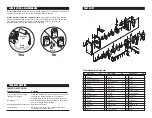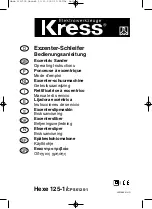
IMPORTANT SAFETY INFORMATION
ASSEMBLY / INSTALLATION
1. You will need to prepare the 1/4 in. Quick-disconnect Coupler Plug to connect to the air
inlet on the sander. Wrap the Coupler Plug with pipe thread seal tape before threading it
into the Air Inlet. Connect the a Quick-Disconnect coupler on a 3/8 in. ID Air Source Hose
to the tool.
Note: If you are not using an automatic oiler system, before operation, add a few drops of
Pneumatic Tool Oil to the airline connection. Add a few drops more after each hour of
continual use.
2. Set the air pressure on your compressor to 90 PSI. Do not exceed the recommended air
pressure of 90 PSI.
3. Check the air connection for leaks. Once you are satisfied there are no leaks, turn off the
air compressor and disconnect the tool.
Clean air of correct air pressure is recommended for the power supply for this tool. A
maximum of 90 PSI at the tool is recommended for most air tools of this class. Check
specifications section for recommended pressure. (Depending on length of air hose and
other circumstances, air pressure at compressor may need to be increased to 100 PSI to
ensure 90 PSI at the tool.)
Water in the air hose and compressor tank contributes to reduced performance and
damage of the air tool. Drain the air tank and filters before each use and as necessary to
keep the air supply dry.
Hose length over 25’ causes loss in line pressure. Increase hose I.D. or increase
compressor pressure to compensate for the pressure loss. Use an in-line pressure
regulator with gauge if air inlet pressure is critical.
AIR SOURCE
13. Check for damaged parts. Before using any tool, any part that appears damaged
should be carefully checked to determine that it will operate properly and perform its
intended function. Check for alignment and binding of moving parts; any broken parts
or mounting fixtures; and any other condition that may affect proper operation. Any
part that is damaged should be properly repaired or replaced by a qualified technician.
14. Maintenance. For your safety, maintenance should be performed regularly by a
qualified technician using original PERFORMANCE TOOLS® replacement parts.
Failure to do so can lead to accidents for the operator. Use of any other parts will void
the warranty. Only use accessories intended for use with this tool. Approved
accessories are available from Performance Tool®. Use only accessories that are
recommended by the manufacturer for your model. Accessories that may be suitable
for one tool may become hazardous when used on another tool.
WARNING: Repetitive motions or exposure to vibration may be harmful to your hands and arms.
WARNING: This product and its packaging contain a chemical known to the State of California
to cause cancer, birth defects, or other reproductive harm.
WARNING: The warnings, cautions, and instructions discussed in this instruction manual cannot
cover all possible conditions and situations that may occur. It must be understood by the
operator that common sense and caution are factors which cannot be built into this product, but
must be supplied by the operator. Read and understand all of the instructions provided in the
instruction manual of this product, as well as, any other tool (s) used with this product.
ATTACHING SANDPAPER
Note: Sandpaper is not included.
Note: The Sander must be disconnected from the air hose before attaching sandpaper.
1. Push down on the Clamp Lever and it will release the Paper Clamp. See FIGURE 1.
2. Insert one end of the sandpaper under the Paper Clamp and snap it closed. Repeat he
process with the rear Paper Clamp.
OPERATION
Lever
Grasp Here
(with fingers)
Paper Clamp
Air Inlet
Clamp Lever
Lever Pivot Area
Sanding Pad
FIGURE 1.
3. Check that the sandpaper fits snugly against the Sanding Pad. If not, repeat the process
above and pull the sandpaper more tightly against the Sanding Pad.
4. Connect the sander to the air compressor.
5. Set the compressor to 90 PSI. Do not exceed 100 PSI.
6. If applicable, secure your workpiece. Use appropriate clamping devices if applicable.
7. Before starting the Sander, place it on the workpiece. If you start the
Sander before you contact the workpiece, the Sander may vibrate out
of your hand once you contact the workpiece.
8. To operate, press the Lever with the palm of your hand while using your fingers to grasp
the Sander. See FIGURE 1. The further you press down on the Lever, the faster the
Sander will rotate. For fine tuning the air pressure, adjust the Regulator Knob.
9. Do not apply force or pressure. Allow the Sander to do the work for you.
Note: During operation, use your other hand to keep the air hose clear of the Sander.
10. When finished, release the Lever and disconnect the air hose from the Sander.
WARNING: Some dust created by power sanding, sawing, grinding, drilling, and other con-
struction activities, contain chemicals known to the State of California to cause cancer, birth
defects or other reproductive harm. Some examples of these chemicals are:
- Lead from lead-based paints
- Crystalline silica from bricks and cement or other masonry products
- Arsenic and chromium from chemically treated lumber
Your risk from these exposures varies, depending on how often you do this type of work.
To reduce your exposure to these chemicals: work in a well ventilated area, and work with
approved safety equipment, such as those dust masks that are specially designed to filter
out microscopic particles.






















